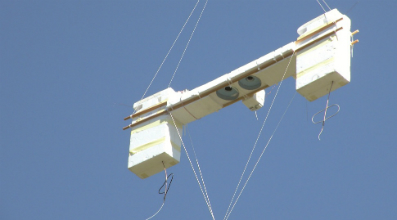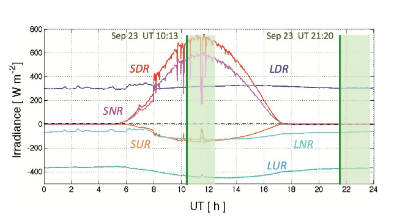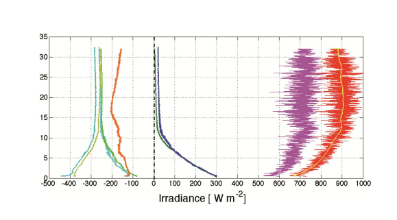Solar short-wave and thermal long-wave radiation at the Earth’s surface and at the top of the atmosphere is commonly measured at surface stations, from aeroplanes and from satellites. However, upper-air observations for climate have recently been given more attention with the initiation of the Global Climate Observing System (GCOS) Reference Upper Air Network (GRUAN) to provide climate-quality measurements of variables in the upper troposphere and lower stratosphere (UTLS).
The primary objectives are to monitor changes in temperature profiles and to characterise water vapour. Temperature and water vapour changes in the atmosphere alter radiative fluxes; so in-situ measurements of the fluxes through the atmosphere, and particularly the UTLS, provide valuable information.
Of greatest importance with regard to climate change are the upward and downward long-wave radiation profiles, which are directly related to radiative forcing through the atmosphere. Measurement of these profiles would provide greater understanding of radaitive forcing and the Earth’s greenhouse effect.
 Researchers from MeteoSwiss used two Meteolabor SRS-C34 radiosondes, which measure air temperature and humidity, and are equipped with additional channels measuring the four thermopile signals and several instrument temperatures from a Kipp & Zonen CNR 4 net radiometer. The CNR 4 was mounted between the two radiosondes as shown in the picture.
Researchers from MeteoSwiss used two Meteolabor SRS-C34 radiosondes, which measure air temperature and humidity, and are equipped with additional channels measuring the four thermopile signals and several instrument temperatures from a Kipp & Zonen CNR 4 net radiometer. The CNR 4 was mounted between the two radiosondes as shown in the picture.
All the body and dome temperatures of the radiometers are measured with the same type of thermocouples as used for air temperature measurement in the SRS-C34. Precise body and dome temperature measurements are crucial to enable corrections for the differential thermal emissions between the radiometer domes and the thermopiles. These result from large temperature gradients caused when the instrument cools from +20°C at the surface to -60°C in the stratosphere.
A new technique is used to lift the equipment, consisting of two balloons with carefully adjusted lifting capacities and a GPS-controlled mechanism to automatically release the ‘carrier’ balloon at a pre-set altitude. The two balloons lift the payload at a constant climb rate of about 5 m/s. After release of the carrier balloon, the payload descends at a similar rate using the ‘parachute’ balloon.
 The first figure shows the radiation components at ground level at the Payerne Baseline Surface Radiation Network (BSRN) station. Short-wave downward (SDR), upward (SUR) and net (SNR) radiation; and the corresponding long-wave radiation, (LDR), (LUR) and (LNR). These are 1 minute averages over 24 hours on 23 September 2011.
The first figure shows the radiation components at ground level at the Payerne Baseline Surface Radiation Network (BSRN) station. Short-wave downward (SDR), upward (SUR) and net (SNR) radiation; and the corresponding long-wave radiation, (LDR), (LUR) and (LNR). These are 1 minute averages over 24 hours on 23 September 2011.
The daytime upper-air radiometry sounding was launched from Payerne at UT 10:13. The payload was recovered in the afternoon and launched again at UT 21:20, nighttime. Upper-air radiation profiles for the day and night flights are shown in the second figure.
 The daytime short-wave downward radiation (SDRd) shows about 680 W/m² at the surface and 880 W/m² at 32 km. This altitude was reached at UT 12:30. The solar height at the sonde’s location was 40.92 degrees, resulting in a direct solar component of 1344 W/m². This is more than 99% of the direct solar irradiance of 1352 W/m² above the atmosphere on 23 September.
The daytime short-wave downward radiation (SDRd) shows about 680 W/m² at the surface and 880 W/m² at 32 km. This altitude was reached at UT 12:30. The solar height at the sonde’s location was 40.92 degrees, resulting in a direct solar component of 1344 W/m². This is more than 99% of the direct solar irradiance of 1352 W/m² above the atmosphere on 23 September.
The measured SDRd signal is rather noisy due to rotation of the payload, and to fi